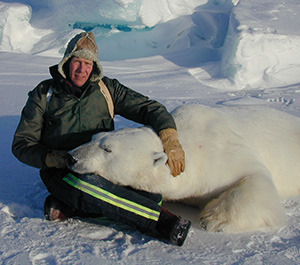Report Projects When Polar Bear Populations Will Begin to Collapse
Published July 20, 2020

For the first time, scientists have answered the critical question of when the persistence of polar bear populations in different parts of the Arctic will be threatened due to sea ice loss from global warming.
Declines in global polar bear populations have long been predicted as sea ice loss continues. This new paper, published today (Monday) in Nature Climate Change, projects when polar bear populations in different parts of the Arctic will cross thresholds of food deprivation, leading to rapid declines in reproduction and survival.
Steven Amstrup, who conceived the project and is a co-author of the paper, is chief scientist of Polar Bears International and an adjunct professor in the University of Wyoming Department of Zoology and Physiology.
Polar bears require sea ice for capturing their seal prey. In response to declining summer sea ice, they are forced onto land or follow the remaining ice as it drifts over deep, unproductive waters. In both cases, polar bears are largely food deprived. Prolonged fasting periods have been linked to reduced body condition, reproduction and survival in some polar bear populations, and continued sea ice loss ultimately threatens polar bears Arctic-wide.
When lowered ice availability will reach critical limits for polar bears in different parts of their range, however, previously had not been determined. This is because data linking sea ice decline to reproduction and survival are lacking for most of the 19 polar bear populations and cannot be measured in advance for future low ice extremes.
“In this study, we flipped the focus so that future reproduction and survival -- the vital demographic parameters of interest -- become model outputs rather than required but unobtainable inputs,” Amstrup says.
“By estimating the whole-body energy content of polar bears and modeling their energy use, we were able to calculate the threshold number of days that polar bears can fast before cub and/or adult survival rates begin to decline,” says Péter Molnár, of the University of Toronto-Scarborough, who built the energetics model and is first author of the paper.
Intersecting these fasting impact thresholds with the projected future number of days that sea ice will be absent, the researchers were able to project when fasting impact thresholds will be exceeded in different parts of the Arctic, says climate scientist Cecilia Bitz, of the University of Washington-Seattle. Bitz, second author of the paper, was one of the original developers of the Community Earth Systems Model, used here to project the number of future ice-free days where each polar bear population lives.
“My colleagues’ approach to modeling the trajectory of the various subpopulations of polar bears represents an innovative solution to uncertainties resulting from previous work. They used first principles of physiology to estimate the ability of polar bears to withstand extended periods of fasting,” says University of Wyoming Professor Merav Ben-David, who has been studying polar bears with Amstrup for 20 years but was not involved in this project. “This is an important tool for our continued conservation efforts of this species.”
The model’s outcomes are consistent with previous projections that polar bears are likely to persist to 2100 only in a few High Arctic populations, based upon current warming trends. By focusing on the biological mechanisms determining how prolonged fasting impacts reproduction and survival, the model now can provide detailed timelines for when and how different populations will be affected. The reliability of the paper’s projections is affirmed by noting that model’s projections captured demographic changes in populations where climate change impacts are already evident.
“Previously, we knew that polar bears would ultimately disappear unless we halt greenhouse gas rise. But knowing when they will begin to disappear in different areas is critical for informing management and policy -- and inspiring action,” Amstrup says. “Our finding that moderate emissions reductions may prolong global persistence, but are unlikely to prevent the extirpation of several populations, emphasizes the urgency of more ambitious emissions cuts.”

